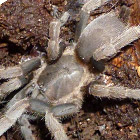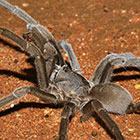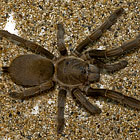Australian Theraphosids are large to very large mygalomorphs with a typical 'Tarantula' appearance, widely sought after as pets, a threat to their numbers in the wild. Their bodies are large and heavy, grey to brown in colour. They have two spinnerets projecting straight out from the rear of the abdomen. They produce a fine hissing sound, giving rise to their common name Whistling Spiders (Queensland Museum). Identifying different genera is a matter of comparing the thickness of the front and back legs. Coremiocnemis and Phlogius spp., have thicker legs at the front than at the back. They are found in in rainforests and gullies or other sheltered cooler spots in open forests. In Selenotholus the first legs are the same thickness as the back legs. In Selenotypus the back legs are thicker than the front legs. Tarantula bite is quickly fatal to dogs and cats, but only one report of serious illness from a bite to a human has occurred. At the time of writing the official name for Phlogius was Selenocosmia. Because there are no true Selenocosmia in Australia the name is in the process of being changed (Queensland Museum).
Coremiocnemis tropix THERAPHOSIDAE Brush Tarantula
Coremiocnemis tropix described by Robert Raven in 2005 from North Queensland was the first record of this genus outside of Malaysia. Unlike... 
Phlogius (Selenocosmia) stirlingi Hogg, 1901 Australian Whistling Spider
Large grey-brown tarantula in drier inland areas, occurring patchily from the NT-WA coast to the NSW VIC border, mostly concentrated in inland NSW,... 
Phlogius crassipes Queensland Whistling Tarantula
Queensland Whistling Tarantula Phlogius (Selenocosmia) crassipes is native to the east coast of Queensland, Australia. Its common name comes... 




